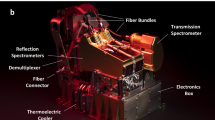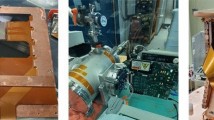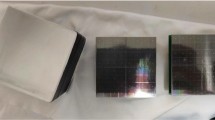Abstract
HgCdTe (MCT) is a very versatile material system for infrared (IR) detection, suitable for high performance detection in a wide range of applications and spectral ranges. Indeed, the ability to tailor the cutoff frequency as close as possible to the needs makes it a perfect candidate for high performance detection. Moreover, the high quality material available today, grown either by molecular beam epitaxy or liquid phase epitaxy, allows for very low dark currents at low temperatures, suitable for low flux detection applications such as science imaging. MCT has also demonstrated robustness to the aggressive environment of space and faces, therefore, a large demand for space applications. A satellite may stare at the earth, in which case detection usually involves a lot of photons, called a high flux scenario. Alternatively, a satellite may stare at outer space for science purposes, in which case the detected photon number is very low, leading to low flux scenarios. This latter case induces very strong constraints onto the detector: low dark current, low noise, (very) large focal plane arrays. The classical structure used to fulfill those requirements are usually p/n MCT photodiodes. This type of structure has been deeply investigated in our laboratory for different spectral bands, in collaboration with the CEA Astrophysics lab. However, another alternative may also be investigated with low excess noise: MCT n/p avalanche photodiodes (APD). This paper reviews the latest achievements obtained on this matter at DEFIR (LETI and Sofradir common laboratory) from the short wave infrared (SWIR) band detection for classical astronomical needs, to long wave infrared (LWIR) band for exoplanet transit spectroscopy, up to very long wave infrared (VLWIR) bands. The different available diode architectures (n/p VHg or p/n, or even APDs) are reviewed, including different available ROIC architectures for low flux detection.
Similar content being viewed by others
References
O. Gravrand, L. Mollard, O. Boulade, V. Moreau, E. Sanson, and G. Destefanis, J. Electron. Mater. 41, 2686 (2012). doi:10.1007/s11664-012-2181-8.
O. Gravrand, E. Borniol, S. Bisotto, L. Mollard, and G. Destefanis, J. Electron. Mater. 36, 981 (2007). doi:10.1007/s11664-007-0151-3.
O. Gravrand, L. Mollard, C. Largeron, N. Baier, E. DeBorniol, and P. Chorier, J. Electron. Mater. 38, 1733 (2009). doi:10.1007/s11664-009-0795-2.
O. Gravrand, G. Destefanis, S. Bisotto, N. Baier, J. Rothman, and L. Mollard, J. Electron. Mater. 42, 3349 (2013). doi:10.1007/s11664-013-2803-9.
J. Beletic, R. Blank, D. Gulbransen, D. Lee, M. Loose, E. Piquette, T. Sprafke, W. Tennant, M. Zandian, and J. Zino, Proceedings of SPIE (2008), p. 70210H. doi:10.1117/ 12.790382.
B. Fièque, L. Martineau, E. Sanson, P. Chorier, O. Boulade, V. Moreau, and H. Geoffray, Proceedings of SPIE, 8176 (2011), pp. 81761I–81761I–13. doi:10.1117/12.898987.
S. Guieu, P. Feautrier, G. Zins, J.-B. Le Bouquin, E. Stadler, P. Kern, and P. Bourget, Proceedings of SPIE (2014), p. 91461N. doi:10.1117/12.2056334.
C. Cervera, O. Gravrand, J.P. Zanatta, C. Lobre, J.L. Santailler, O. Boulade, and V. Moreau, J. Electron. Mater. (2016, under review).
A. Delannoy, B. Fièque, P. Chorier, and C. Riuné, SPIE (2015), p. 96390R. doi:10.1117/12.2197239.
J.W. Beletic, R. Blank, D. Gulbransen, D. Lee, M. Loose, E.C. Piquette, T. Sprafke, W.E. Tennant, M. Zandian, and J. Zino, Proceedings of SPIE (2008), p. 7021. doi:10.1117/12.790382.
G. Perrais, O. Gravrand, J. Baylet, G. Destefanis, and J. Rothman, J. Electron. Mater. 36, 963 (2007). doi:10.1007/s11664-007-0147-z.
E. De Borniol, J. Rothman, F. Salveti, and P. Feautrier, ICSO2014 (Tenerife, 2014), p. 65468.
W.E. Tennant, D. Lee, M. Zandian, E. Piquette, and M. Carmody, J. Electron. Mater. 37, 1406 (2008). doi:10.1007/s11664-008-0426-3.
G.L. Hansen, J.L. Schmit, and T.N. Casselman, J. Appl. Phys. 53, 7099 (1982).
C. Cervera, N. Baier, O. Gravrand, L. Mollard, C. Lobre, G. Destefanis, and V. Moreau, Proceedings of SPIE (2015), p. 945129. doi:10.1117/12.2179216.
N. Baier, C. Cervera, O. Gravrand, L. Mollard, C. Lobre, G. Destefanis, and V. Moreau, J. Electron. Mater. 44, 3144 (2015). doi:10.1007/s11664-015-3851-0.
P.-E. Crouzet, L. Duvet, F. de Wit, T. Beaufort, S. Blommaert, B. Butler, G. Van Duinkerken, J. ter Haar, J. Heijnen, K. van der Luijt, and H. Smit, SPIE (2015), p. 96390X. doi:10.1117/12.2208268.
Author information
Authors and Affiliations
Corresponding author
Rights and permissions
About this article
Cite this article
Gravrand, O., Rothman, J., Cervera, C. et al. HgCdTe Detectors for Space and Science Imaging: General Issues and Latest Achievements. J. Electron. Mater. 45, 4532–4541 (2016). https://doi.org/10.1007/s11664-016-4516-3
Received:
Accepted:
Published:
Issue Date:
DOI: https://doi.org/10.1007/s11664-016-4516-3




